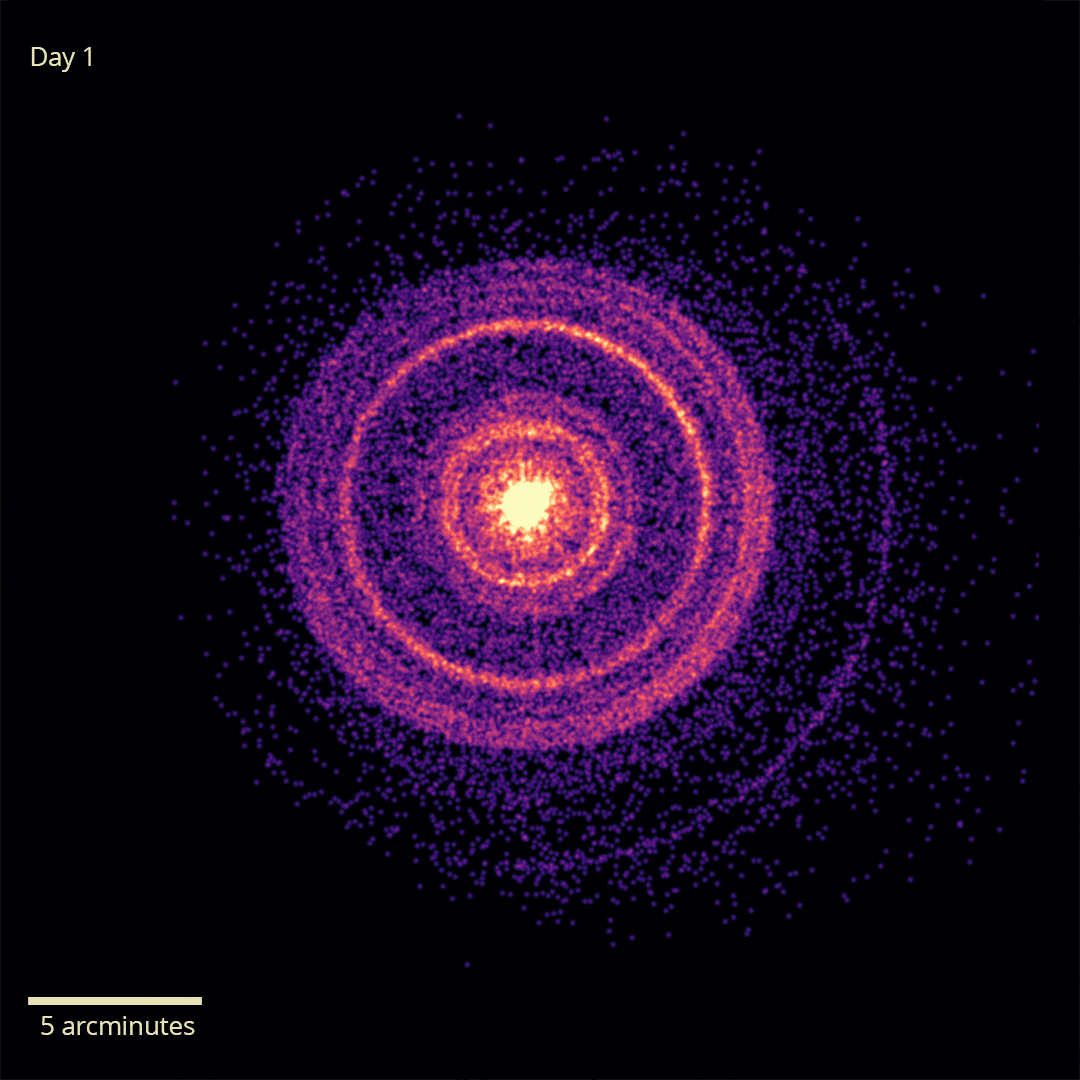
Artist's view of the particle jet that generated the GRB 221009A gamma-ray burst. Nasa / Swift / Cruz deWilde
On October 9, 2022, at 13:16 and 59.99 seconds, a gamma-ray burst (GRB) dazzled almost all the X-ray and gamma ray detectors available at the time. Since their discovery, multi-wavelength telescopes in space and on the ground have continuously monitored these events. This outburst, named GRB221009A, shook the world community of astrophysicists, who have since been analysing it to understand the physical phenomena that triggered this most intense burst of energy in our history.
|
|
X-rays detection due to the scattering of light from the initial explosion of GRB 221009A by the dust of our galaxy, has led to the formation of expanding rings. This "movie" (in arbitrary colors) shows these rings formed by X-rays detected by NASA's Swift telescope. It was created by combining images captured over a 12-day period. Credit A. Beardmore, University of Leicester, NASA, Switf |
GRBs originate from two distinct astrophysical phenomena:
- short gamma-ray bursts (lasting less than 2 s) resulting from the merger of two neutron stars ;
- long gamma-ray bursts (lasting more than 2 s and up to several minutes) resulting from the collapse of a massive star.
The 600s flash was thus associated with a long gamma-ray burst of an intensity surpassing any previously recorded.
By chance, GRB 221009A is one of the closest long gamma ray bursts ever observed. The combination of its extreme luminosity (around 8 solar masses released in gamma rays in the space of 10 minutes) and rare proximity (around 2 billion light-years) make it the brightest burst ever observed since they were first detected 55 years ago. According to statistics on the populations of GRBs already known, this could be a unique event in the history of mankind - one every ten thousand years!
By misfortune, GRB 221009A is located in our galactic plane, and the radiation (radio, visible, X, UV, IR photons, etc.) tracked by the telescopes undergoes strong absorption, which means that interpretation of the data requires a good mastery of this "filtering" by the dust of our galaxy.
Teams from Irfu's DAp and DPHP, as part of their international collaboration with space satellites and ground-based telescopes, contributed to the exciting science of this unique event.
|
Integral |
GRANDMA and Kilonova-Catcher |
James Webb |
Solar Orbiter |
HE.S.S.S |
Gamma-ray burst emissions are divided into two distinct phases:
- The first, known as the bright, rapid emission phase, lasts only a few seconds
- Integral and SolarOrbiter have been able to detect this "prompt".
- The second, slower, fades more slowly and may persist for several days or even weeks. This so-called "afterglow" emission is caused by the acceleration of electrons because of the explosion's impact with the surrounding environment.
- Integral, GRANDMA, JWST, H.E.S.S. have detected this "afterglow".
To find out about the observations made in each experiment, read the highlights in French.
To be continued....
GRB 221009A is a major event in the study of violent transients in the Universe. Many of its physical properties make it a unique gamma-ray burst in the zoo of GRBs so far detected. Additional observations over the next few months, particularly in the radio and X-ray domains, will provide valuable additional information to shed light on the physical processes at work. There's no doubt that GRB 221009A will keep scientists busy for months to come. A data set standardized across the various communities (X, UVOIR, radio, GeV) is currently being drawn up, and will enable theorists to build more appropriate models in the months to come.
Contacts Irfu:
- Philippe Laurent et Diego GOTZ, for Integral
- Damien Turpin , for GRANDMA
- Emeric Le Floc’h, for JWST
- Aline MEURIS , Olivier Limousin , for SolarOrbiter
- Fabian Schussler, for H.E.S.S.
• Structure and evolution of the Universe › High energy cosmic phenomena and astroparticles
• Department of Astrophysics (DAp) // UMR AIM • The Particle Physics Division
• High Energy Cosmic Phenomena • Astroparticles • Cosmology
• HESS • INTEGRAL • JWST • Solar Orbiter









